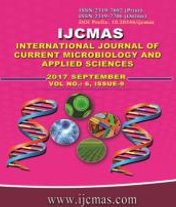


 National Academy of Agricultural Sciences (NAAS)
National Academy of Agricultural Sciences (NAAS)

|
PRINT ISSN : 2319-7692
Online ISSN : 2319-7706 Issues : 12 per year Publisher : Excellent Publishers Email : editorijcmas@gmail.com / submit@ijcmas.com Editor-in-chief: Dr.M.Prakash Index Copernicus ICV 2018: 95.39 NAAS RATING 2020: 5.38 |
Patchouli is an important aromatic plant from Lamiaceae family, well known for its essential oil properties. Root rot disease of patchouli is caused by Fusarium solani (Mart.) Sacc., a severe and wide spread disease in India and major constraint to patchouli cultivation in Assam. A roving survey was conducted on root rot incidence based on the occurrences of disease in major patchouli growing areas of Nagaon, Biswanath, Golaghat and Jorhat districts of Assam. Highest percentage of the disease incidence was recorded in the districts of Nagaon (69.01%). Field evaluations were conducted during monsoon season by combining fungicide, bio-agents and oilcake for the management of root rot disease. In field trial, all the treatments were found significantly superior over inoculated control in reducing disease incidence. Integration of seedling root dipping and soil drenching with Carbendazim @ 0.1% and soil application of Biofor-pf-2 @ 100 g/plant and MOC @ 50 g/plant (T7) recorded least percent disease incidence (5.58%) and maximum herbage yield as compared to inoculated control (88.88%). It was followed by soil application of Biofor-pf-2 @ 100 g/plant and MOC @ 50 g/plant (T6), seedling root dip and soil drenching with Carbendazim @ 0.1% and soil application of MOC @ 50 g/plant (T5) recorded 8.33% and 11.11% PDI, respectively. The integration of Biofor-pf-2 @ 100 g/plant with Carbendazim @ 0.1% (T4) recorded maximum disease incidence (33.33%) in comparison to the inoculated control.
 |
 |
 |
 |
 |